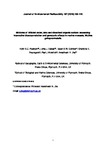Mixtures of tritiated water, zinc and dissolved organic carbon: Assessing interactive bioaccumulation and genotoxic effects in marine mussels, Mytilus galloprovincialis
| dc.contributor.author | Pearson, HBC | |
| dc.contributor.author | Dallas, LJ | |
| dc.contributor.author | Comber, Sean | |
| dc.contributor.author | Braungardt, Charlotte | |
| dc.contributor.author | Worsfold, Paul | |
| dc.contributor.author | Jha, Awadhesh | |
| dc.date.accessioned | 2018-09-13T11:28:43Z | |
| dc.date.available | 2018-09-13T11:28:43Z | |
| dc.date.issued | 2018-07 | |
| dc.identifier.issn | 0265-931X | |
| dc.identifier.issn | 1879-1700 | |
| dc.identifier.other | C | |
| dc.identifier.uri | http://hdl.handle.net/10026.1/12351 | |
| dc.description | publisher: Elsevier articletitle: Mixtures of tritiated water, zinc and dissolved organic carbon: Assessing interactive bioaccumulation and genotoxic effects in marine mussels, Mytilus galloprovincialis journaltitle: Journal of Environmental Radioactivity articlelink: https://doi.org/10.1016/j.jenvrad.2017.12.018 content_type: article copyright: © 2018 Elsevier Ltd. All rights reserved. | |
| dc.description.abstract |
Release of tritium (3H) in the marine environment is of concern with respect to its potential bioaccumulation and detrimental impact on the biota. Previous studies have investigated the uptake and toxicity of this radionuclide in marine mussels, and the interaction of 3H with dissolved organic ligands and elevated temperature. However, despite the well-established view that toxicity is partly governed by chemical speciation, and that toxic effects of mixture of contaminants are not always additive, there have been no studies linking the prevailing chemistry of exposure waters with observed biological effects and tissue specific accumulation of 3H in combination with other constituents commonly found in natural waters. This study exposed the marine mussel Mytilus galloprovincialis for 14 days to mixtures of 3H (as tritiated water, HTO) and zinc (Zn) at 5 Mbq L-1, and 383, 1913 and 3825 nM Zn, respectively, to investigate (a) 3H and Zn partitioning in soft tissues of mussels, and (b) DNA damage in haemocytes, determined using the single cell gel electrophoresis or the comet assay. Additionally, the extent of association of 3H with dissolved organic carbon (DOC, added as humic acid) over the exposure period was investigated in order to aid the interpretation of biological uptake and effects. Results concluded a clear antagonistic effect of Zn on 3H-induced DNA damage at all Zn concentrations used, likely explained by the importance of Zn in DNA repair enzymes. The interaction of DOC with 3H was variable, with strong 3H-DOC associations observed in the first 3 d of the experiment. The secretion of 3H-binding ligands by the mussels is suggested as a possible mechanism for early biological control of 3H toxicity. The results suggest risk assessments for radionuclides in the environment require consideration of potential mixture effects. | |
| dc.format.extent | 133-143 | |
| dc.format.medium | Print-Electronic | |
| dc.language | en | |
| dc.language.iso | en | |
| dc.publisher | Elsevier | |
| dc.subject | Tritium | |
| dc.subject | Zinc | |
| dc.subject | Organic ligands | |
| dc.subject | Mussels | |
| dc.subject | Bioaccumulation | |
| dc.subject | Comet assay | |
| dc.title | Mixtures of tritiated water, zinc and dissolved organic carbon: Assessing interactive bioaccumulation and genotoxic effects in marine mussels, Mytilus galloprovincialis | |
| dc.type | journal-article | |
| dc.type | Journal Article | |
| plymouth.author-url | https://www.webofscience.com/api/gateway?GWVersion=2&SrcApp=PARTNER_APP&SrcAuth=LinksAMR&KeyUT=WOS:000428833900016&DestLinkType=FullRecord&DestApp=ALL_WOS&UsrCustomerID=11bb513d99f797142bcfeffcc58ea008 | |
| plymouth.volume | 187 | |
| plymouth.publication-status | Published | |
| plymouth.journal | Journal of Environmental Radioactivity | |
| dc.identifier.doi | 10.1016/j.jenvrad.2017.12.018 | |
| plymouth.organisational-group | /Plymouth | |
| plymouth.organisational-group | /Plymouth/Admin Group - REF | |
| plymouth.organisational-group | /Plymouth/Admin Group - REF/REF Admin Group - FoSE | |
| plymouth.organisational-group | /Plymouth/Faculty of Science and Engineering | |
| plymouth.organisational-group | /Plymouth/Faculty of Science and Engineering/School of Biological and Marine Sciences | |
| plymouth.organisational-group | /Plymouth/Faculty of Science and Engineering/School of Geography, Earth and Environmental Sciences | |
| plymouth.organisational-group | /Plymouth/REF 2021 Researchers by UoA | |
| plymouth.organisational-group | /Plymouth/REF 2021 Researchers by UoA/UoA06 Agriculture, Veterinary and Food Science | |
| plymouth.organisational-group | /Plymouth/Research Groups | |
| plymouth.organisational-group | /Plymouth/Research Groups/BEACh | |
| plymouth.organisational-group | /Plymouth/Research Groups/Marine Institute | |
| plymouth.organisational-group | /Plymouth/Users by role | |
| plymouth.organisational-group | /Plymouth/Users by role/Academics | |
| plymouth.organisational-group | /Plymouth/Users by role/Researchers in ResearchFish submission | |
| dc.publisher.place | England | |
| dcterms.dateAccepted | 2017-12-27 | |
| dc.rights.embargodate | 2019-2-23 | |
| dc.identifier.eissn | 1879-1700 | |
| dc.rights.embargoperiod | Not known | |
| rioxxterms.versionofrecord | 10.1016/j.jenvrad.2017.12.018 | |
| rioxxterms.licenseref.uri | http://www.rioxx.net/licenses/all-rights-reserved | |
| rioxxterms.licenseref.startdate | 2018-07 | |
| rioxxterms.type | Journal Article/Review |


